Nestled amidst the lush landscapes of Bali, the Jatiluwih Rice Terraces stand as a testament to the harmonious coexistence between humanity and nature. These verdant terraces, carved into the hillsides with intricate precision, have played a pivotal role in the cultural, agricultural, and spiritual life of the Balinese people for centuries.
The Jatiluwih Rice Terraces are a UNESCO World Heritage Site, renowned for their breathtaking beauty and the traditional farming practices that have sustained them for generations. Their cascading tiers, adorned with vibrant greenery and dotted with traditional irrigation systems, create a mesmerizing visual spectacle that has captivated visitors from around the globe.
History of Jatiluwih Rice Terraces
The Jatiluwih Rice Terraces are a UNESCO World Heritage Site located in the Tabanan Regency of Bali, Indonesia. The terraces were built centuries ago by the local Balinese people and have been used to cultivate rice ever since.
The terraces are a testament to the ingenuity and hard work of the Balinese people. They are a beautiful and sustainable way to grow rice, and they have been a vital part of the local economy for centuries.
Construction and Development
The Jatiluwih Rice Terraces were built over a period of centuries, starting around the 9th century AD. The terraces were built by hand, using traditional methods that have been passed down from generation to generation.
The terraces are divided into small plots, each of which is owned by a different family. The families work together to maintain the terraces and to grow the rice.
Cultural Significance, Jatiluwih rice terraces
The Jatiluwih Rice Terraces are more than just a place to grow rice. They are also a symbol of the Balinese people’s culture and heritage.
The terraces are used for religious ceremonies and festivals. They are also a popular tourist destination, and they provide a valuable source of income for the local community.
Geographical Features and Location
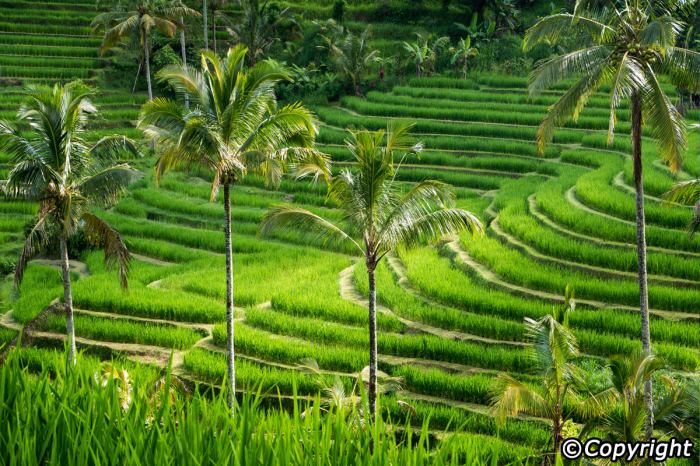
The Jatiluwih Rice Terraces are situated in the western part of Bali, Indonesia, in the Tabanan Regency. They cover an area of approximately 630 hectares and are located at an altitude ranging from 500 to 800 meters above sea level.
The terraces are surrounded by lush green hills, cascading waterfalls, and picturesque villages.
The climate in the region is tropical, with an average temperature of 22 degrees Celsius. The area receives abundant rainfall, which contributes to the lush vegetation and fertile soil conditions. The soil is volcanic in origin and is rich in nutrients, making it ideal for rice cultivation.
Surrounding Landscape
The Jatiluwih Rice Terraces are surrounded by a breathtaking natural landscape. The area is home to a variety of flora and fauna, including rice paddies, tropical forests, and wildlife. The terraces are also interspersed with traditional Balinese villages, temples, and shrines, adding to the cultural and historical significance of the region.
Agricultural Practices and Techniques

The Jatiluwih Rice Terraces showcase a remarkable blend of traditional farming practices and innovative techniques that have been passed down through generations. These methods ensure sustainable agriculture and contribute to the unique beauty of the landscape.
Water management is paramount in the terraces. The intricate irrigation system channels water from the mountains to each terrace, providing a reliable water supply for the rice crops. Farmers meticulously adjust water levels to meet the specific needs of the rice plants at different stages of growth.
The Jatiluwih Rice Terraces, a UNESCO World Heritage Site, offer breathtaking views of verdant rice paddies cascading down the hillsides. Its beauty has been captured in Hello world! , a captivating travelogue that showcases the wonders of this natural masterpiece.
The terraces’ intricate irrigation system, dating back centuries, is a testament to the ingenuity and agricultural prowess of the Balinese people. As the sun sets, casting a golden glow over the landscape, Jatiluwih transforms into a surreal and unforgettable sight.
Crop Rotation
Crop rotation is an essential practice in the terraces. Farmers alternate rice cultivation with other crops, such as soybeans, peanuts, and vegetables. This helps maintain soil fertility, prevent pests and diseases, and improve overall crop yields.
Pest Control
Integrated pest management (IPM) is employed to minimize the use of chemical pesticides. Farmers use natural predators, such as spiders and frogs, to control pests. They also practice crop diversification and maintain a healthy ecosystem to promote beneficial insects.
Cultural and Spiritual Significance: Jatiluwih Rice Terraces
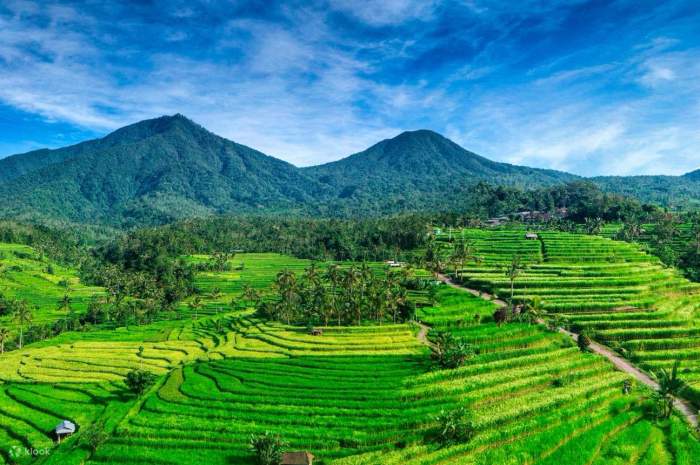
Jatiluwih Rice Terraces are not just an agricultural marvel but also hold deep cultural and spiritual significance for the local community. These terraces are considered a symbol of harmony between humans and nature, representing the intricate balance between cultivation and preservation.
The terraces play a crucial role in religious ceremonies and festivals, particularly during the annual harvest festival. The festival, known as Nyepi, is a time for the community to give thanks for the rice harvest and to pray for a bountiful future.
During the festival, offerings are made to the gods and ancestors, and traditional dances and music are performed in the terraces.
Religious Ceremonies
The Jatiluwih Rice Terraces are believed to be the abode of Dewi Sri, the goddess of rice. Offerings are made to Dewi Sri at the start of each planting season and during the harvest to ensure a successful crop. The terraces are also used for other religious ceremonies, such as weddings and funerals.
Community Gatherings
The terraces are not only a place of spiritual significance but also a central gathering place for the community. People come together in the terraces to socialize, share stories, and celebrate important events. The terraces are a place where the community can connect with each other and with their shared heritage.
Tourism and Conservation
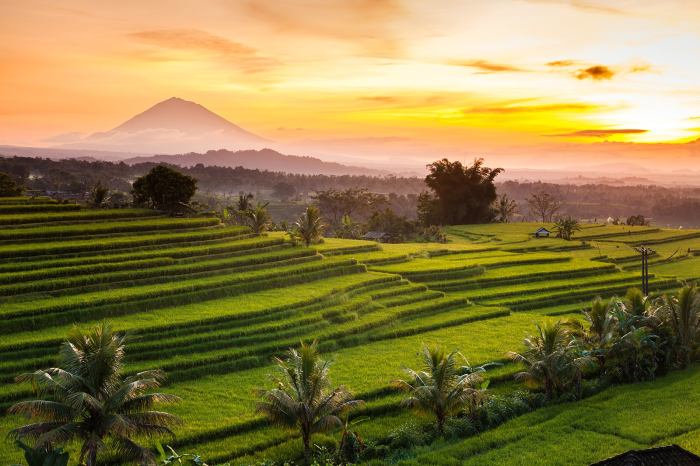
The Jatiluwih Rice Terraces have become a popular tourist destination, attracting both domestic and international visitors. Tourism has brought economic benefits to the local community, but it has also posed challenges to the conservation of the terraces.
One of the challenges of tourism is the impact of foot traffic on the terraces. The terraces are fragile, and excessive foot traffic can damage the soil and the rice plants. To address this issue, the government has implemented measures to limit the number of visitors and to designate specific paths for tourists to follow.
Sustainable Tourism and Conservation Efforts
There are a number of opportunities for sustainable tourism and conservation efforts at the Jatiluwih Rice Terraces. One opportunity is to promote responsible tourism practices among visitors. This includes educating visitors about the importance of staying on designated paths and avoiding littering.
Another opportunity is to develop alternative sources of income for the local community, such as homestays and guided tours. This can help to reduce the reliance on tourism and promote sustainable practices.
Recognition and Awards
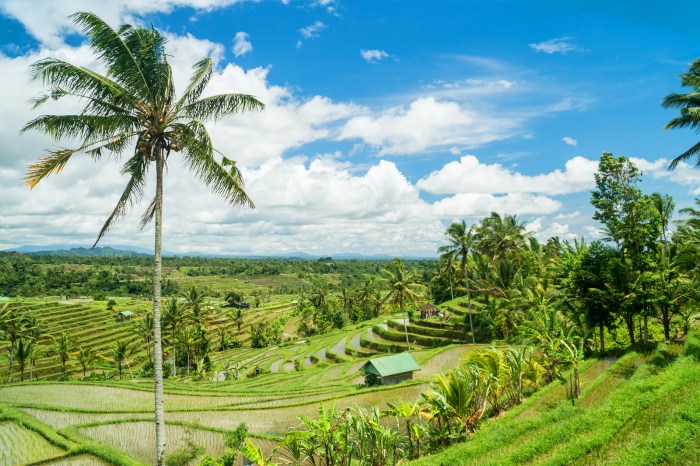
The Jatiluwih Rice Terraces have received numerous awards and recognitions for their outstanding beauty, cultural significance, and sustainable agricultural practices.
One of the most prestigious recognitions is the designation as a UNESCO World Heritage Site in 2012. This designation recognizes the terraces’ universal value and importance for humanity. It has significantly raised the profile of the terraces and increased their visibility on the global stage.
Other Notable Awards and Recognitions:
- Aga Khan Award for Architecture (1995)
- Global 500 Roll of Honour for Environmental Achievement (2002)
- National Geographic World Legacy Award (2009)
These awards have not only honored the Jatiluwih Rice Terraces but have also contributed to their conservation and protection. The terraces are now recognized as a valuable cultural and natural asset, and efforts are being made to ensure their preservation for future generations.
Design and Structure
The Jatiluwih Rice Terraces exhibit an intricate and meticulously planned design that showcases the ingenuity and craftsmanship of Balinese farmers. The terraces are laid out in a cascading pattern, following the contours of the land, with each terrace forming a separate and distinct unit.
Layout and Dimensions
The terraces are arranged in a series of long, narrow strips, running parallel to each other and separated by narrow embankments. The average width of each terrace ranges from 5 to 10 meters, while the length can vary depending on the slope of the land.
The overall area covered by the terraces is approximately 600 hectares.
Elevation and Slope
The terraces are located at an elevation ranging from 500 to 850 meters above sea level. The slope of the land varies significantly, with some terraces having a gentle incline while others are situated on steep slopes. The average slope of the terraces is around 20 degrees, which allows for efficient water management and prevents erosion.
Embankments and Irrigation
The embankments between the terraces serve multiple purposes. They provide structural support, preventing the terraces from collapsing. Additionally, they act as channels for irrigation water, which is diverted from the nearby Tukad Yeh Ho River and distributed throughout the terraces.
The irrigation system is designed to ensure that each terrace receives an adequate supply of water for the cultivation of rice.
Flora and Fauna

The Jatiluwih Rice Terraces are a rich and diverse ecosystem, home to a wide variety of plant and animal species. The terraces are located in a tropical rainforest climate, which provides ideal conditions for a wide range of life forms.
The vegetation of the terraces is dominated by rice paddies, but there are also a variety of other plants growing in the area, including trees, shrubs, and herbs. The trees provide shade for the rice plants and help to prevent erosion.
The shrubs and herbs provide food and shelter for a variety of animals.
Animal Species
The Jatiluwih Rice Terraces are home to a variety of animal species, including birds, mammals, reptiles, and amphibians. The birds are the most visible animals in the area, and they can be seen flying over the terraces or perched in the trees.
The mammals include monkeys, squirrels, and bats. The reptiles include snakes, lizards, and turtles. The amphibians include frogs and toads.
Ecological Importance and Biodiversity
The Jatiluwih Rice Terraces are an important ecosystem for a number of reasons. The terraces provide food and shelter for a variety of plant and animal species. The terraces also help to regulate the water flow in the area, which is important for both the plants and animals that live there.
The terraces are also a popular tourist destination, which provides economic benefits to the local community.
Local Communities and Livelihoods

The Jatiluwih Rice Terraces have played a pivotal role in sustaining the livelihoods of local communities for centuries. These terraces provide a vital source of income through agricultural activities, tourism, and other related industries.
The primary economic benefit derived from the terraces is rice cultivation. Local farmers rely on the fertile soil and abundant water resources to grow rice, which is a staple food in Indonesia. The terraces also support other agricultural activities such as vegetable farming and livestock grazing.
These activities provide additional income and ensure food security for the local population.
Tourism and Related Industries
In recent years, the Jatiluwih Rice Terraces have gained international recognition as a UNESCO World Heritage Site, attracting a significant number of tourists. This has led to the development of tourism-related industries, such as homestays, restaurants, and souvenir shops. These businesses provide additional income opportunities for local communities and contribute to the overall economic development of the region.
Social Benefits
Beyond economic benefits, the Jatiluwih Rice Terraces also have important social implications. The terraces have fostered a sense of community among the local people, who share a common cultural heritage and work together to maintain the terraces. The terraces also serve as a gathering place for social events, festivals, and religious ceremonies.Overall, the Jatiluwih Rice Terraces are an integral part of the local communities’ livelihoods, providing both economic and social benefits.
The terraces contribute to the region’s food security, generate income through tourism, and foster a strong sense of community.
Challenges and Future Prospects
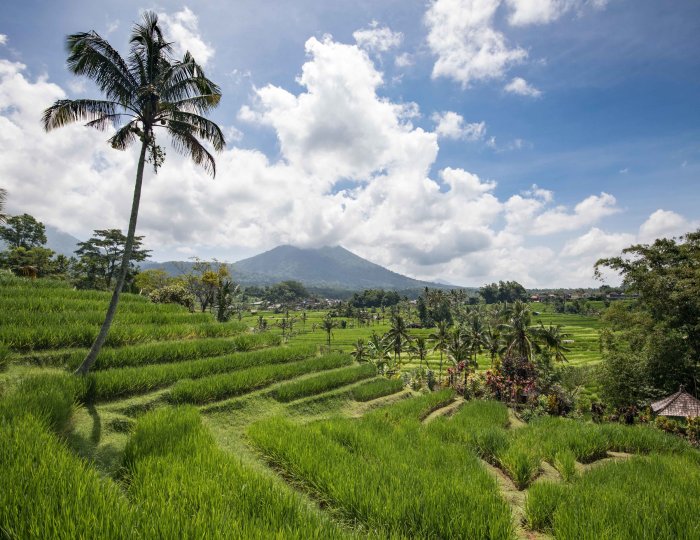
The Jatiluwih Rice Terraces face several challenges that threaten their preservation and sustainability. These include:
- Urbanization and Development:As tourism and economic development increase in the surrounding areas, there is a risk of encroachment and conversion of agricultural land for non-agricultural purposes, such as housing and commercial development.
- Climate Change:Changing weather patterns, such as increased rainfall intensity and more frequent droughts, can affect crop yields and terrace stability.
- Agricultural Intensification:The use of chemical fertilizers and pesticides can damage the delicate ecosystem of the terraces and pollute the water sources.
- Tourism Pressure:While tourism is an important source of income for local communities, it can also lead to overcrowding, pollution, and damage to the terraces if not managed sustainably.
To address these challenges and ensure the future preservation of the Jatiluwih Rice Terraces, several strategies are being implemented, including:
- Land Use Planning and Zoning:Regulating land use and zoning laws to protect agricultural areas and prevent uncontrolled development.
- Sustainable Agricultural Practices:Promoting organic farming and other sustainable agricultural practices to reduce environmental impact and maintain the health of the terraces.
- Community-Based Tourism:Developing tourism models that involve local communities and prioritize the preservation of the terraces, such as guided tours and homestays.
- Education and Awareness:Raising awareness about the importance of the Jatiluwih Rice Terraces and the need for their conservation among tourists, local communities, and policymakers.
By implementing these strategies and fostering collaboration among stakeholders, the Jatiluwih Rice Terraces can continue to be a source of pride and inspiration for future generations, while also providing economic and environmental benefits to the surrounding communities.
Conclusive Thoughts
As we delve into the depths of the Jatiluwih Rice Terraces, we uncover a rich tapestry of cultural traditions, agricultural ingenuity, and environmental conservation. These terraces are not merely a picturesque landscape but a living testament to the enduring spirit of the Balinese people and their deep connection to the land.
As we bid farewell to this extraordinary destination, let us carry with us the lessons it imparts about sustainable living and the enduring power of human ingenuity.
Expert Answers
What is the history behind the Jatiluwih Rice Terraces?
The Jatiluwih Rice Terraces have been cultivated for centuries, with their origins dating back to the 9th century. The terraces were developed by the Balinese people using traditional irrigation techniques, known as “subak,” which have been passed down through generations.
What is the cultural significance of the Jatiluwih Rice Terraces?
The Jatiluwih Rice Terraces hold immense cultural significance for the Balinese people. They are considered a sacred landscape and play a vital role in religious ceremonies, festivals, and community gatherings.
What are the agricultural practices used in the Jatiluwih Rice Terraces?
The Jatiluwih Rice Terraces are cultivated using traditional farming methods that have been passed down through generations. These practices include water management, crop rotation, and pest control, all of which are essential for maintaining the health and productivity of the terraces.
What is the ecological importance of the Jatiluwih Rice Terraces?
The Jatiluwih Rice Terraces are home to a diverse range of plant and animal species. The terraces provide a habitat for many endangered and endemic species, and they also play a vital role in regulating the local climate and water resources.